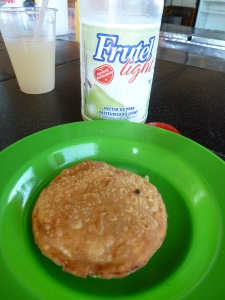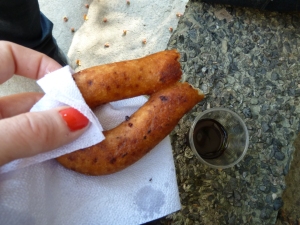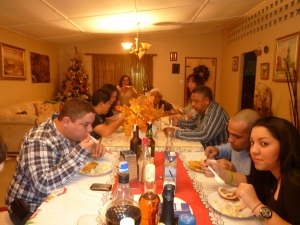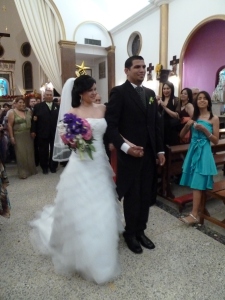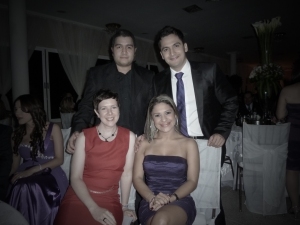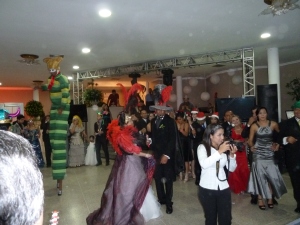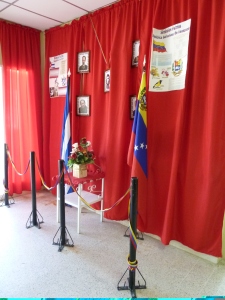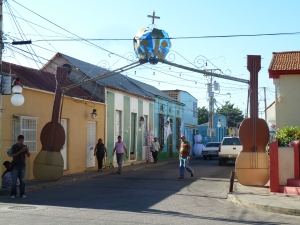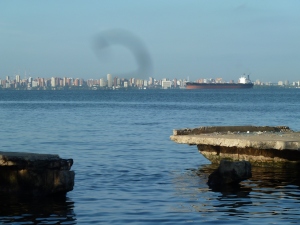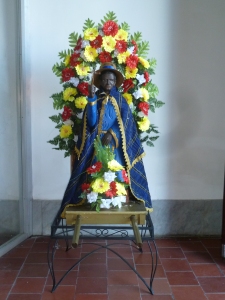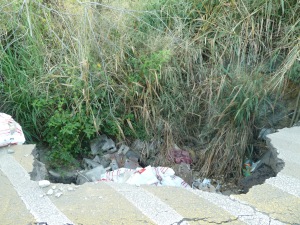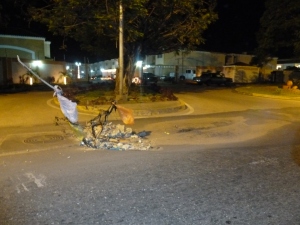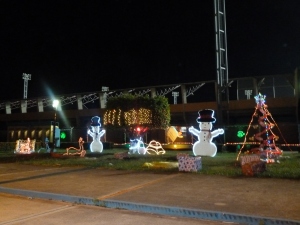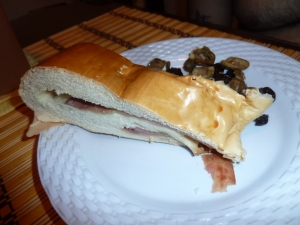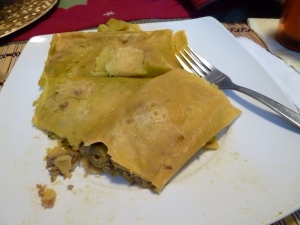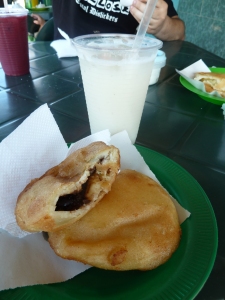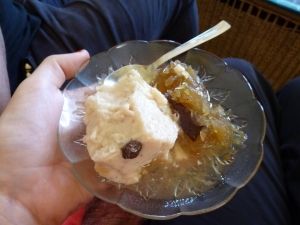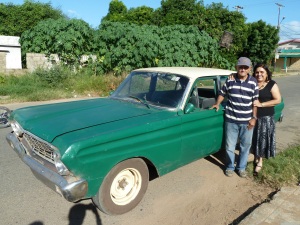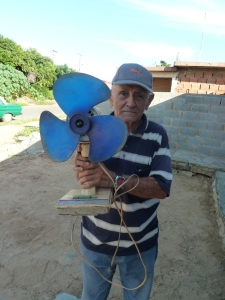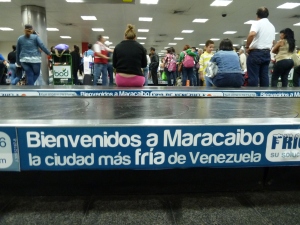
Waiting for luggage at Maracaibo airport. For those who've not been there, Maracaibo is the hottest place in Venezuela so this advert for air conditioning (that says it is the coldest) is a joke!
I went to Cabimas (near Maracaibo) in Zulia State in Venezuela to spend Xmas and New Year with Emmanuel and his mum. The journey to get there was epic – I took a 12 hour day bus from Cordoba to Buenos Aires, then the bus to the airport, then I stayed at Buenos Aires airport overnight, then I flew to Caracas in the morning before making a connecting flight to Maracaibo in the early evening where Emmanuel and his mum collected me and drove us to Cabimas. I think it took me about 2 days to get there!
Of course, it was boiling hot (as always) in Cabimas but it was nice to be somewhere familiar again after so many months on the road. Emmanuel still had his arm in a cast so we couldn’t really go anywhere, which meant we could enjoy the delights(?!) of Cabimas. This basically meant Emmanuel’s mum cooked us yummy food and fresh juices at home, then Emmanuel would go to his physiotherapy with the Cuban doctors, and then we might go out to some of our favourite local haunts for typical street food – arepas, empanadas, mandocas, taquenos, cachapas, hallacas, cepillados, ice-cream, chinese fried rice – anything deep-fried or full of sugar really. You can read more about typical Venezuelan food here. It also gave me plenty of time to organise and upload my travel photos and watch American TV with Spanish subtitles.
I think this is the third time I’ve spent Xmas and New Year in Cabimas so I knew the routine by now. On Xmas eve we had dinner at home and then we went out for a drive to see some friends. I noticed a big difference from the last time (and even more so from the first time) I visited Cabimas in that there were hardly any people on the streets around Xmas and New Year. Usually there were always people sat outside their houses having a drink and you could just drop by to visit people. I guess the increasingly dangerous security situation means that people don’t even feel safe to sit and drink outside their house any more, which makes me sad as that seemed like such a typical part of life here.
On New Years eve we went to Tia Juana to visit Emmanuel’s aunt and her family. New Year in Venezuela means eating a typical meal, just before midnight, of hallacas and pan de jamon (I had vegetarian hallacas and no pan de jamon, obviously) and then eating 12 grapes at midnight (one wish for each grape) and then doing some typical superstitious rituals for the year ahead, such as walking round the block with an empty suitcase (to bring travel) or throwing coins on the roof (to bring money). All the old people, and woman, usually cry as they remember the year that has just passed. Then there are always lots of fireworks, often being thrown by kids in the street, so I always feel lucky if I survive the night without incident! There were so many fireworks over Tia Juana that I joked they were better than Sydney and London. Only a week or so later did we find out that Henry (a Venezuelan friend who now lives in Toronto) was visiting his family a few houses down, as we all complained that there had been nothing to do or people to visit after the fireworks were finished.
We also went to a wedding and I had to borrow a dress from Dayana (Emmanuel’s sister) because I had nothing smart to wear, and people really dress up for weddings in Venezuela (actually, Venezuelan’s dress up even to go to the shops, so imagine how dressed up they are for weddings, Xmas, New Year etc…). My random outfit included Dayana’s red shift dress (thanks Dayana!), my Bolivian tyre sandals, my Bolivian jungle necklace and my old Bolivian blanket purse. I even caved into peer pressure and visited a Venezuelan beauty salon to get a manicure and pedicure. I have always avoided this because everyone is so obsessed with beauty and going to the salon in Venezuela that I feel the need to rebel against it and be as crusty as possible. I have to say though, after months of travelling it did feel like a real treat to get my nails done and visiting the salon was fun because the ladies wanted to know what a gringa (from England) was doing in Cabimas (you don’t really see any foreigners in Cabimas, despite all the oil companies, so I’m always treated like a curious sight when we go to the supermarket or anywhere). I also tried to make my hair look a bit more presentable with a bit of hair wax, even though I was still sporting my growing-out Bolivian hair-cut. Of course, everyone was very polite and didn’t comment on my attire even though they were all dressed up to the nines – this is typical when I visit Venezuela, I always feel underdressed at any formal occasion but actually it feels like rebelling, so I quite like it!
We went to the church first. Because of the acoustics I couldn’t actually understand very much of the service but there was a point where the vicar/priest told everyone off for not going to church and for chewing gum(!?). He also asked the bride and groom what love meant and when he wasn’t happy with the bride’s answer, he told her off in front of everyone! After the service we went to the party and ate lots of yummy food and drank good whisky (Old Parr, which, typically for Venezuela was brought by the bottle to the tables). There was live music and DJs (no embarrassing dancing from me this time) and the Hora Loca (crazy hour) which we don’t have at English weddings. It’s like carnival time where the bride and groom put on carnivalesque outfits, everyone else gets some kind of carnival mask or accessory, and the band plays carnival music for an hour or so. Like all good weddings, the conga also gets thrown in at this point.
I was also reminded about the obsession with Blackberrys in Venezuela – EVERYONE has one (even if they have no money) so they can use the free Blackberry PIN chat. Having an iPhone in Venezuela is kind of a little bit alternative, which I find kind of funny considering the obsession with iPhones in other countries.
I also got to go to a live gaita party this time. Gaita is a typical type of music from Zulia Statethat is played at Xmas. Jandeira taught me how to dance to gaita (it has to be the easiest of all Latin dances, requiring no fancy footwork or hip moving, hence why I could manage it) and the atmosphere was great.
I went a couple of times with Emmanuel to the local clinics for the check-up and physiotherapy on his arm. Doing ‘normal’ things in Venezuela always fascinates me because it is so different from home but there is usually also a disproportionate amount of waiting/disorganised queuing involved and a system that is completely unfathomable, even to locals, so you have to ask a million questions all the time about what is going on. The entrance to the physio clinic was decked out with a presentation on Venezuela and Cuba (Cuba provides Venezuela with doctors and nurses in exchange for cheap petrol) and the local doctor’s surgery also has some Venezuela/Cuba propaganda on display and showed the national TV channel on rotation (basically, a mouthpiece for Hugo Chavez and his latest social projects, this time the main one was free housing for poor people – can’t complain about that).
We didn’t go to San Benito this year but Emmanuel’s mum did want to go to mass in Altagracia. Luckily, I didn’t have to go to the mass and spent a tranquil couple of hours walking around the town taking photos, chilling out and watching people walk home from the party that was only just finishing from the night before.
Going to Maracaibo is always a treat as it feels like going to a big city where things happen! We only went a couple of times though but did go to an interesting bar one night in a shopping centre that always reminds me of the Southbank in London because it is a 60s concrete development. I was the only one to get ID’d (of course) under the pretence that I was supposed to be carrying my passport with me at all times in case the police showed up and needed to check it. It would be completely stupid to carry my original passport around in Venezuela so I carry a copy. The guy on the door required some sweet talking from my friends before eventually letting us in.
There are always loads of giant pot holes in the roads in and around Cabimas and Maracaibo, even though most of the money for the country is generated there (from the oil industry). To try to make things safer, the public often fill up the holes with random stuff, and sometimes even put flags in the holes, which always makes me laugh. This time I saw a particularly spectacular hole that was almost the size of a car and on the main road from Cabimas to Maracaibo where there is no street lighting at night – madness!
I only stayed in Cabimas for a couple of weeks before heading back to Buenos Aires for a proper visit this time.
